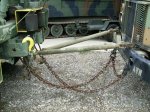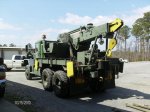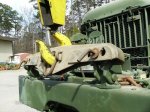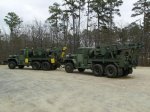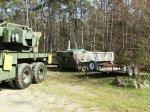Considering that my Dad and I have an M816 and also that we are taking one belonging to the Montgomery County Military Museum on the Arkansas MVPA convoy in a few weeks, I figured it would be a good idea to know how to properly tow other vehicles. I've used the crane a lot to move engines, power packs, generators, a ring mount, boat lifts, boats, etc., but I had never really towed anything with one. Here are some of my thoughts and observations.
1) Safety first! 5 Ton wreckers and everything related to them are heavy, so be careful not to hurt yourself! I weighed one of the two groove 3/4" snatch blocks for the rear winch and it weighs 115 pounds! Two people would make most any of this a lot easier. Be sure to double and triple check all of your towing connections between vehicles.
2) My first towing candidate was an M35A3. I did this by myself so I had to take the tow bar apart to handle it. Hooking up was relatively easy. I used a pick handle to prop up the tow bar so I could back up to it. I used one of the 16', 5/8" link wrecker chains to rig safety chains. Since I did not go very far I did not hook up lights on the back of the towed vehicle. I tried driving straight forward onto the paved surface then backing up in a straight line. It seemed to work okay. Then I tried to drive down a gravel road with a couple turns in it. The wheels would start to track properly, but when the turn got tighter they would steer the opposite way! The only way I made it around the turns was to stop and go straighten out the wheels on the A3, drive a few feet, and do it again! I think I could have drug the front end of the A3 around the corners on the loose gravel, but I didn't want to take a chance on damaging anything. I also considered using ratchet straps hooked to the steering wheel to hold the wheels straight through the turns on gravel then removing them when I got to pavement, but never got around to trying it. It seemed to track okay in tight turns on pavement, but since I was doing this by myself I didn't try turning out onto the road. I think if I had a second person to steer the A3 through turns on loose surfaces that this combination would work okay. If I had to do it again by myself, I would lift the front end. If I was only going to be on paved surfaces, I think I'd try flat towing it. I'll try an A2 with the stock NDCCs some time and see how it tracks compared to this truck.
3) I figured it was time to step things up a little so next I tried towing a second M816 with the front end lifted off of the ground. I installed the axle clamps first and hooked up the tow bar. I had enough room to run the axle clamp chains between the axle housing and brake lines without taking the lines loose. Considering the length of a 5 ton with a winch on the front I had to use the tow bar in the fully extended position to to have enough clearance in turns. After getting everything hooked up to the towed 816, I used a lug wrench handle to prop up the tow bar and back under it. I then flipped the shackles around and hooked up the whiffletree. The crane effortlessly lifted the almost 11,000 pound front end on the second 816 with the transmission in 3rd gear and the engine at idle. For safety chains I used two of the 12', 3/4" link wrecker chains. I wrapped the ends with pear shaped links around the frame just behind the bumper and ran the chain back through the pear link. Then, with them crossed, I hooked the pear links on the other ends through the shackles under the bumperettes. This left the hooks hanging down in just the right position to take up little slack in the chains to keep them off of the ground. The air lines were then hooked up (don't forget to cross them!). This combination backed easily around corners, much like a trailer. It drove okay on level ground and going downhill, but then I had to go back up the hill. There was enough weight on the back end that I had no steering on the tow vehicle! The front end just plowed straight ahead with the wheels turned! The only way I made it back up the hill was to get lined up going straight up it and when I got to the top I could steer again. The manual said that you could tow vehicles up to 39,000 pounds this way.
4) Since that didn't work very well I tried flat towing the M816. Safety chains and air lines were rigged the same as before but of course the tow bar was attached to the bumper shackle mounting brackets instead of the axle. Finally, something that worked like it was supposed to! This combination towed very nicely. It tracked well on both pavement and gravel ,including the turns where the A3 wouldn't. Although it was really big and slow, I was comfortable driving it. I drove around a few miles on some small, local roads and everything seemed to work okay. The air lines hooked to the second M816 applied the brakes very well. When the brakes were applied and released, all of the air from both truck's systems bled off through the vent on the tow vehicle's air/hydraulic cylinder so it took a few seconds for the towed vehicle's brakes to release completely. I tried backing this combination around a little curve in the open gravel parking lot and it didn't work. Flat towing is the only way I would attempt to tow another 5 ton.
5) Well, I might as well try towing something with tracks while I'm at it! Actually, the museum building is going to expand soon so I had to move it anyway. This was the easiest of my towing exercises. Since I didn't leave our yard I didn't worry about safety chains (not sure how I would have hooked them up anyway!). Once I got the tow bar on it and started driving around I was surprised at how easy it rolled. I had to drive straight down a dirt road and back it in perpendicular to the road. It actually backed very easily, much like a regular trailer would.
1) Safety first! 5 Ton wreckers and everything related to them are heavy, so be careful not to hurt yourself! I weighed one of the two groove 3/4" snatch blocks for the rear winch and it weighs 115 pounds! Two people would make most any of this a lot easier. Be sure to double and triple check all of your towing connections between vehicles.
2) My first towing candidate was an M35A3. I did this by myself so I had to take the tow bar apart to handle it. Hooking up was relatively easy. I used a pick handle to prop up the tow bar so I could back up to it. I used one of the 16', 5/8" link wrecker chains to rig safety chains. Since I did not go very far I did not hook up lights on the back of the towed vehicle. I tried driving straight forward onto the paved surface then backing up in a straight line. It seemed to work okay. Then I tried to drive down a gravel road with a couple turns in it. The wheels would start to track properly, but when the turn got tighter they would steer the opposite way! The only way I made it around the turns was to stop and go straighten out the wheels on the A3, drive a few feet, and do it again! I think I could have drug the front end of the A3 around the corners on the loose gravel, but I didn't want to take a chance on damaging anything. I also considered using ratchet straps hooked to the steering wheel to hold the wheels straight through the turns on gravel then removing them when I got to pavement, but never got around to trying it. It seemed to track okay in tight turns on pavement, but since I was doing this by myself I didn't try turning out onto the road. I think if I had a second person to steer the A3 through turns on loose surfaces that this combination would work okay. If I had to do it again by myself, I would lift the front end. If I was only going to be on paved surfaces, I think I'd try flat towing it. I'll try an A2 with the stock NDCCs some time and see how it tracks compared to this truck.
3) I figured it was time to step things up a little so next I tried towing a second M816 with the front end lifted off of the ground. I installed the axle clamps first and hooked up the tow bar. I had enough room to run the axle clamp chains between the axle housing and brake lines without taking the lines loose. Considering the length of a 5 ton with a winch on the front I had to use the tow bar in the fully extended position to to have enough clearance in turns. After getting everything hooked up to the towed 816, I used a lug wrench handle to prop up the tow bar and back under it. I then flipped the shackles around and hooked up the whiffletree. The crane effortlessly lifted the almost 11,000 pound front end on the second 816 with the transmission in 3rd gear and the engine at idle. For safety chains I used two of the 12', 3/4" link wrecker chains. I wrapped the ends with pear shaped links around the frame just behind the bumper and ran the chain back through the pear link. Then, with them crossed, I hooked the pear links on the other ends through the shackles under the bumperettes. This left the hooks hanging down in just the right position to take up little slack in the chains to keep them off of the ground. The air lines were then hooked up (don't forget to cross them!). This combination backed easily around corners, much like a trailer. It drove okay on level ground and going downhill, but then I had to go back up the hill. There was enough weight on the back end that I had no steering on the tow vehicle! The front end just plowed straight ahead with the wheels turned! The only way I made it back up the hill was to get lined up going straight up it and when I got to the top I could steer again. The manual said that you could tow vehicles up to 39,000 pounds this way.
4) Since that didn't work very well I tried flat towing the M816. Safety chains and air lines were rigged the same as before but of course the tow bar was attached to the bumper shackle mounting brackets instead of the axle. Finally, something that worked like it was supposed to! This combination towed very nicely. It tracked well on both pavement and gravel ,including the turns where the A3 wouldn't. Although it was really big and slow, I was comfortable driving it. I drove around a few miles on some small, local roads and everything seemed to work okay. The air lines hooked to the second M816 applied the brakes very well. When the brakes were applied and released, all of the air from both truck's systems bled off through the vent on the tow vehicle's air/hydraulic cylinder so it took a few seconds for the towed vehicle's brakes to release completely. I tried backing this combination around a little curve in the open gravel parking lot and it didn't work. Flat towing is the only way I would attempt to tow another 5 ton.
5) Well, I might as well try towing something with tracks while I'm at it! Actually, the museum building is going to expand soon so I had to move it anyway. This was the easiest of my towing exercises. Since I didn't leave our yard I didn't worry about safety chains (not sure how I would have hooked them up anyway!). Once I got the tow bar on it and started driving around I was surprised at how easy it rolled. I had to drive straight down a dirt road and back it in perpendicular to the road. It actually backed very easily, much like a regular trailer would.
Attachments
-
91 KB Views: 268
-
89.8 KB Views: 281
-
101.6 KB Views: 266
-
102.2 KB Views: 267
-
102.2 KB Views: 276
-
82.2 KB Views: 266
-
97 KB Views: 284
-
80.4 KB Views: 271
-
75.7 KB Views: 263
-
80.4 KB Views: 270
Last edited:







